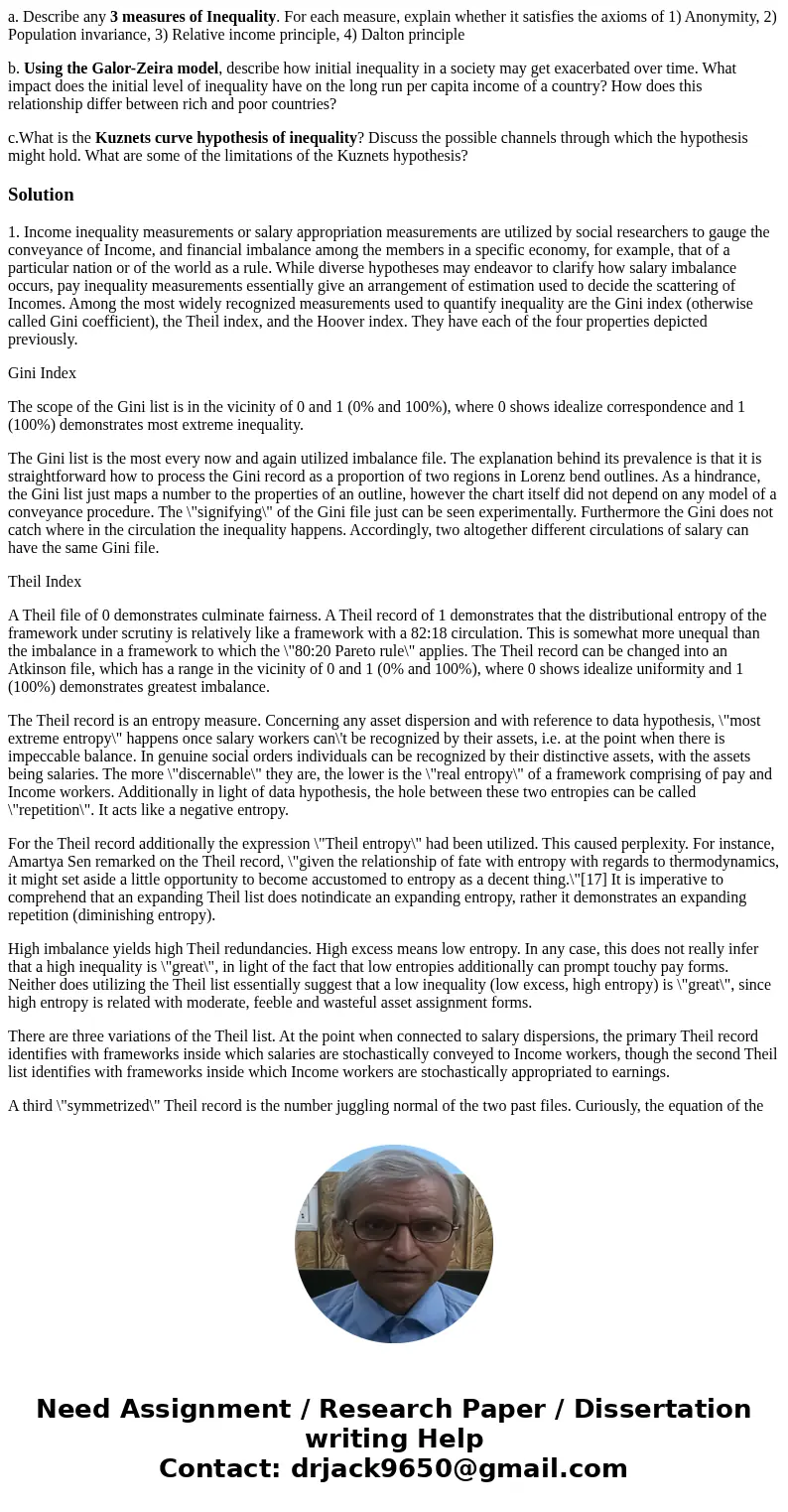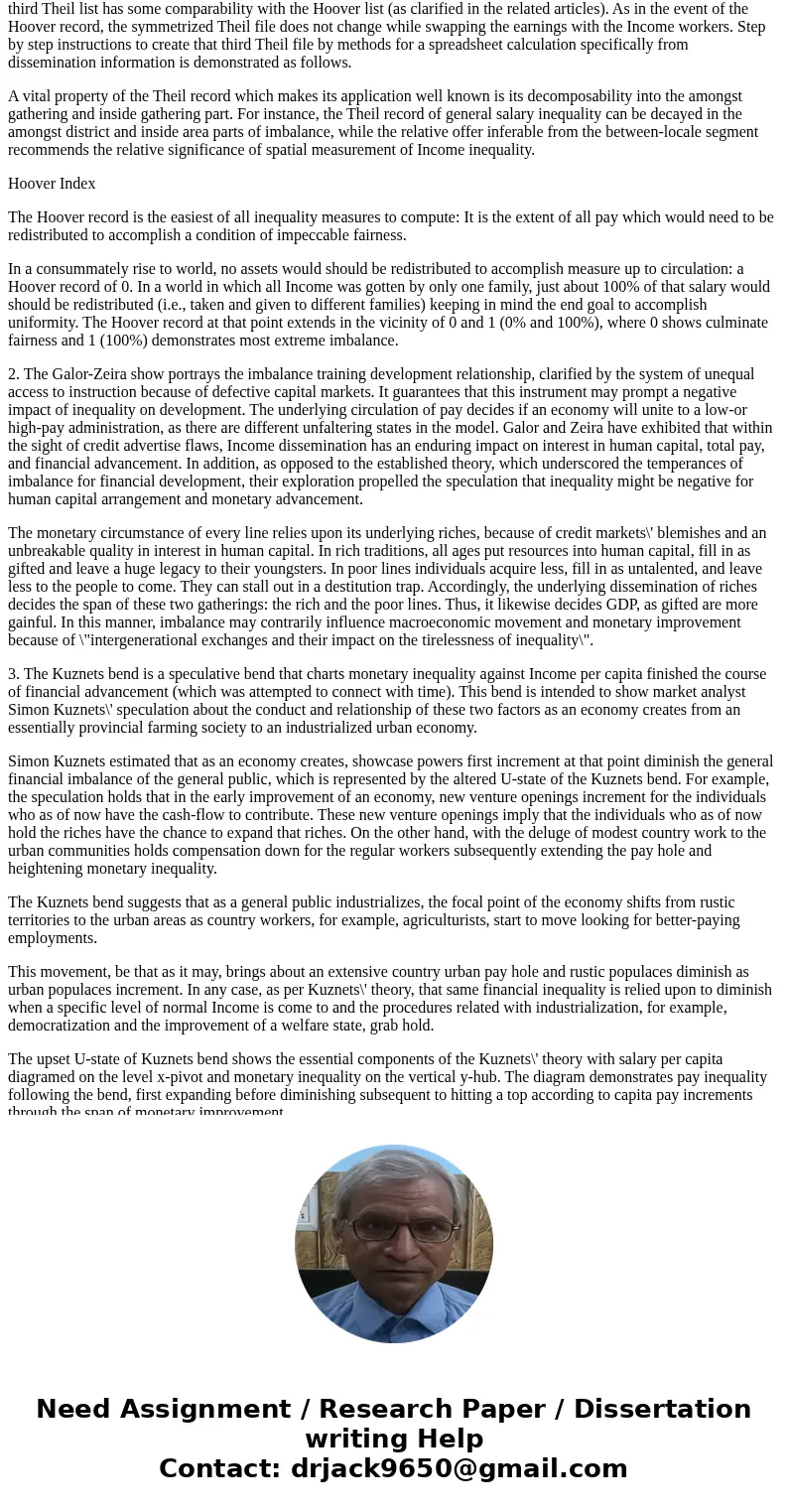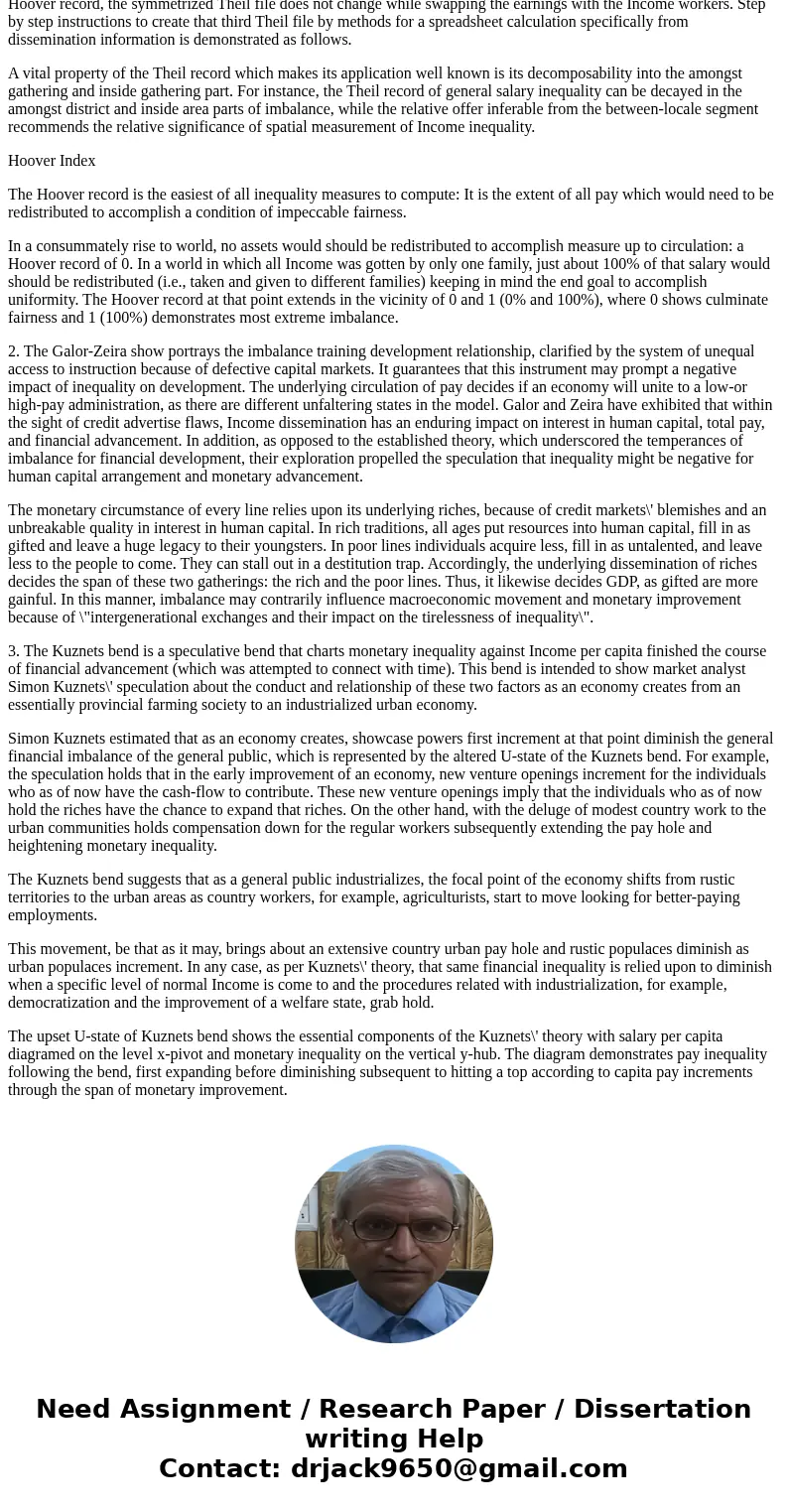a Describe any 3 measures of Inequality For each measure exp
a. Describe any 3 measures of Inequality. For each measure, explain whether it satisfies the axioms of 1) Anonymity, 2) Population invariance, 3) Relative income principle, 4) Dalton principle
b. Using the Galor-Zeira model, describe how initial inequality in a society may get exacerbated over time. What impact does the initial level of inequality have on the long run per capita income of a country? How does this relationship differ between rich and poor countries?
c.What is the Kuznets curve hypothesis of inequality? Discuss the possible channels through which the hypothesis might hold. What are some of the limitations of the Kuznets hypothesis?
Solution
1. Income inequality measurements or salary appropriation measurements are utilized by social researchers to gauge the conveyance of Income, and financial imbalance among the members in a specific economy, for example, that of a particular nation or of the world as a rule. While diverse hypotheses may endeavor to clarify how salary imbalance occurs, pay inequality measurements essentially give an arrangement of estimation used to decide the scattering of Incomes. Among the most widely recognized measurements used to quantify inequality are the Gini index (otherwise called Gini coefficient), the Theil index, and the Hoover index. They have each of the four properties depicted previously.
Gini Index
The scope of the Gini list is in the vicinity of 0 and 1 (0% and 100%), where 0 shows idealize correspondence and 1 (100%) demonstrates most extreme inequality.
The Gini list is the most every now and again utilized imbalance file. The explanation behind its prevalence is that it is straightforward how to process the Gini record as a proportion of two regions in Lorenz bend outlines. As a hindrance, the Gini list just maps a number to the properties of an outline, however the chart itself did not depend on any model of a conveyance procedure. The \"signifying\" of the Gini file just can be seen experimentally. Furthermore the Gini does not catch where in the circulation the inequality happens. Accordingly, two altogether different circulations of salary can have the same Gini file.
Theil Index
A Theil file of 0 demonstrates culminate fairness. A Theil record of 1 demonstrates that the distributional entropy of the framework under scrutiny is relatively like a framework with a 82:18 circulation. This is somewhat more unequal than the imbalance in a framework to which the \"80:20 Pareto rule\" applies. The Theil record can be changed into an Atkinson file, which has a range in the vicinity of 0 and 1 (0% and 100%), where 0 shows idealize uniformity and 1 (100%) demonstrates greatest imbalance.
The Theil record is an entropy measure. Concerning any asset dispersion and with reference to data hypothesis, \"most extreme entropy\" happens once salary workers can\'t be recognized by their assets, i.e. at the point when there is impeccable balance. In genuine social orders individuals can be recognized by their distinctive assets, with the assets being salaries. The more \"discernable\" they are, the lower is the \"real entropy\" of a framework comprising of pay and Income workers. Additionally in light of data hypothesis, the hole between these two entropies can be called \"repetition\". It acts like a negative entropy.
For the Theil record additionally the expression \"Theil entropy\" had been utilized. This caused perplexity. For instance, Amartya Sen remarked on the Theil record, \"given the relationship of fate with entropy with regards to thermodynamics, it might set aside a little opportunity to become accustomed to entropy as a decent thing.\"[17] It is imperative to comprehend that an expanding Theil list does notindicate an expanding entropy, rather it demonstrates an expanding repetition (diminishing entropy).
High imbalance yields high Theil redundancies. High excess means low entropy. In any case, this does not really infer that a high inequality is \"great\", in light of the fact that low entropies additionally can prompt touchy pay forms. Neither does utilizing the Theil list essentially suggest that a low inequality (low excess, high entropy) is \"great\", since high entropy is related with moderate, feeble and wasteful asset assignment forms.
There are three variations of the Theil list. At the point when connected to salary dispersions, the primary Theil record identifies with frameworks inside which salaries are stochastically conveyed to Income workers, though the second Theil list identifies with frameworks inside which Income workers are stochastically appropriated to earnings.
A third \"symmetrized\" Theil record is the number juggling normal of the two past files. Curiously, the equation of the third Theil list has some comparability with the Hoover list (as clarified in the related articles). As in the event of the Hoover record, the symmetrized Theil file does not change while swapping the earnings with the Income workers. Step by step instructions to create that third Theil file by methods for a spreadsheet calculation specifically from dissemination information is demonstrated as follows.
A vital property of the Theil record which makes its application well known is its decomposability into the amongst gathering and inside gathering part. For instance, the Theil record of general salary inequality can be decayed in the amongst district and inside area parts of imbalance, while the relative offer inferable from the between-locale segment recommends the relative significance of spatial measurement of Income inequality.
Hoover Index
The Hoover record is the easiest of all inequality measures to compute: It is the extent of all pay which would need to be redistributed to accomplish a condition of impeccable fairness.
In a consummately rise to world, no assets would should be redistributed to accomplish measure up to circulation: a Hoover record of 0. In a world in which all Income was gotten by only one family, just about 100% of that salary would should be redistributed (i.e., taken and given to different families) keeping in mind the end goal to accomplish uniformity. The Hoover record at that point extends in the vicinity of 0 and 1 (0% and 100%), where 0 shows culminate fairness and 1 (100%) demonstrates most extreme imbalance.
2. The Galor-Zeira show portrays the imbalance training development relationship, clarified by the system of unequal access to instruction because of defective capital markets. It guarantees that this instrument may prompt a negative impact of inequality on development. The underlying circulation of pay decides if an economy will unite to a low-or high-pay administration, as there are different unfaltering states in the model. Galor and Zeira have exhibited that within the sight of credit advertise flaws, Income dissemination has an enduring impact on interest in human capital, total pay, and financial advancement. In addition, as opposed to the established theory, which underscored the temperances of imbalance for financial development, their exploration propelled the speculation that inequality might be negative for human capital arrangement and monetary advancement.
The monetary circumstance of every line relies upon its underlying riches, because of credit markets\' blemishes and an unbreakable quality in interest in human capital. In rich traditions, all ages put resources into human capital, fill in as gifted and leave a huge legacy to their youngsters. In poor lines individuals acquire less, fill in as untalented, and leave less to the people to come. They can stall out in a destitution trap. Accordingly, the underlying dissemination of riches decides the span of these two gatherings: the rich and the poor lines. Thus, it likewise decides GDP, as gifted are more gainful. In this manner, imbalance may contrarily influence macroeconomic movement and monetary improvement because of \"intergenerational exchanges and their impact on the tirelessness of inequality\".
3. The Kuznets bend is a speculative bend that charts monetary inequality against Income per capita finished the course of financial advancement (which was attempted to connect with time). This bend is intended to show market analyst Simon Kuznets\' speculation about the conduct and relationship of these two factors as an economy creates from an essentially provincial farming society to an industrialized urban economy.
Simon Kuznets estimated that as an economy creates, showcase powers first increment at that point diminish the general financial imbalance of the general public, which is represented by the altered U-state of the Kuznets bend. For example, the speculation holds that in the early improvement of an economy, new venture openings increment for the individuals who as of now have the cash-flow to contribute. These new venture openings imply that the individuals who as of now hold the riches have the chance to expand that riches. On the other hand, with the deluge of modest country work to the urban communities holds compensation down for the regular workers subsequently extending the pay hole and heightening monetary inequality.
The Kuznets bend suggests that as a general public industrializes, the focal point of the economy shifts from rustic territories to the urban areas as country workers, for example, agriculturists, start to move looking for better-paying employments.
This movement, be that as it may, brings about an extensive country urban pay hole and rustic populaces diminish as urban populaces increment. In any case, as per Kuznets\' theory, that same financial inequality is relied upon to diminish when a specific level of normal Income is come to and the procedures related with industrialization, for example, democratization and the improvement of a welfare state, grab hold.
The upset U-state of Kuznets bend shows the essential components of the Kuznets\' theory with salary per capita diagramed on the level x-pivot and monetary inequality on the vertical y-hub. The diagram demonstrates pay inequality following the bend, first expanding before diminishing subsequent to hitting a top according to capita pay increments through the span of monetary improvement.



 Homework Sourse
Homework Sourse